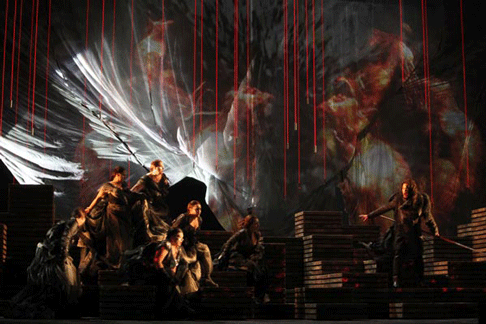11 Dec 2010
Die Walküre at La Scala
The opening night of the new season at Teatro alla Scala Milan is a gala event, the most glamorous in the entire Italian opera year.

The opening night of the new season at Teatro alla Scala Milan is a gala event, the most glamorous in the entire Italian opera year.
Because it’s so high profile it attracts inordinate extra-musical interest. This year the big news was a huge demonstration outside the theatre protesting a 37% cut in arts funding. Violence broke out, many were injured. When the President of Italy, Giorgio Napolitano, and his entourage took their seats in the royal box, festooned with ten thousand roses, Daniel Barenboim made an impromptu speech supporting the protesters. “In the names of the colleagues who play, sing, dance and work, not only here but in all theatres, I am here to tell you we are deeply worried for the future of culture in the country and in Europe.” Massive applause. The President joined in.
Barenboim’s never been afraid of standing up for what he believes in. He’s also a passionate believer in Wagner’s music and is one of its most committed interpreters. This performance of Wagner’s Die Walküre, broadcast live internationally, may not have been the most exemplary in orchestral terms, but there’s no denying Barenboim’s flair.
The cast was truly grand luxeas befitted the occasion. Rene Pape had cancelled a few weeks before but there were stars aplenty. Waltraud Meier, Nina Stemme, Ekaterina Gubanova, John Tomlinson, Simon O’Neill and Vitalij Kowaljow, replacing the indisposed Rene Pape.
Waltraud Meier is one of the greatest Wagnerians of all time. Any opportunity to hear her cannot be missed, for she has created all the roles and understands their place in the grand scheme. Although she’s no longer in the first bloom of youth, her artistry is such that she can create a Sieglinde so ravishing that she seems transfigured. Sieglinde’s past has been too traumatic for her to be an ingenue. so Meier’s interpretation emphasizes the way Seiglinde blossoms as love awakens her, like a parched plant unfurling after a long drought. When Meier sings “Du bist der Lenz”, her voice warms and opens outwards. It’s so expressive that she creates the idea of the world ash tree bursting into leaf despite the barren surroundings.
Wonderful as Meier is, even she is outclassed by Nina Stemme’s Brünnhilde. Stemme is so lively and vivacious that she completely dispels any memories of historic, matronly Brünnhildes, with metal breastplates, horned helmets and spears. Instead, she’s dressed in what could pass as a modern if quirky evening dress, a blend of lace and bombazine with hints of Goth and punk. The costume (Tim van Steenbergen) fixes Brünnhilde at once in Wagner’s world of political rebellion and in present day ideas of generation conflict.
Stemme’s youthful energy and spark highlight her idealism and high principles. She’s not intimidated by Wotan, however much she loves him. Here, already in germination, is the Brünnhilde of Götterdämmerung who will defy death itself to right the wrongs that have gone before. Stemme’s voice pulsates with intensity, and softens with tenderness, her control firm and measured. Stemme’s vigour might have been even more impressive against a more dominant Wotan, but Vitalij Kowaljow was adequate rather than brooding. Nonetheless, of the male singers in this performance, he held up best.
John Tomlinson’s Hunding was more genial than malevolent, more aging rock star (complete with pony tail) than abusive brigand. Sieglinde might have been more bored than cowed. Still, everyone loves Tomlinson and the role isn’t huge. More worrying was Simon O’Neill’s Siegmund. Apparently he’d been indisposed in rehearsal. Perhaps he should have cancelled, for he had vocal problems from the start, After his voice cracked on “Schwester!”, things deteriorated. Since O’Neill isn’t especially mobile physically, he couldn’t fall back on acting skills when the voice failed. There is no shame in cancellation, and it’s better not to risk long term damage.
Ekaterina Gubanova’s Fricka was superb, elevating the role from a minor part to something far more profound. Usually the role is unsympathetic as our feelings about Hunding are negative, and it’s Fricka who demands that he be revenged, even though he married Sieglinde by force. Gubanova looks and sings with youthful radiance, connected more to the idea of growth and refreshment than to barrenness and drought. After all she stands for moral principles, just as Brünnhilde does. Wotan defiles marriage by scattering offspring everywhere, destroying many lives. Fricka stands for good, even if she’s stern, as Gubanova’s interesting portrayal suggests.
 Scene from Act III
Scene from Act III
Unfortunately the direction and staging did little to develop the ideas inherent in the opera and in the superb performances by Meier, Stemme and Gubanova. Hunding’s house in the First Act was very well expressed - a cube of mirrors, glowing with light, encroached upon by dark chaos. Perhaps this was what Guy Cassiers, the director, referred to as the inward-looking paranoia of gated communities, when interviewed. After all, Hunding’s hearth is a down-market Valhalla and Hunding was a bandit, just as Wotan and Alberich got ahead through deception.
Yet this good idea didn’t develop. Act Three was a forest of vertical slivers lit by green light to suggest a forest, nothing more. The magic fire in Act Three was just silly. Nonetheless, compared to the recent Met Das Rheingold (Robert Lepage) Cassier’s direction had merit, especially in terms of Personenregie and vocal finesse. With experienced stars like Meier, Stemme and Gubanova, he could hardly go wrong. One could imagine a truly original ground-breaking interpretation of Die Walküre with stars like this but it’s too much to expect in reality. This La Scala Die Walküre wasn’t remarkable in itself (apart from the three leading female roles) but could spark off further insight that might bear fruit in future productions.
Anne Ozorio